In This Issue
The opinions, beliefs and viewpoints expressed in this publication are those of the authors. They do not necessarily reflect the opinions, beliefs, viewpoints or official policies of Autism Society Alberta.
|
|
|
Let's Talk About Talking
Karla Power
Autism can come with many gifts, as well as many barriers. One of the biggest barriers that our boys face is being non-verbal. They are both able to make noises, and have said sporadic words like “Mom” and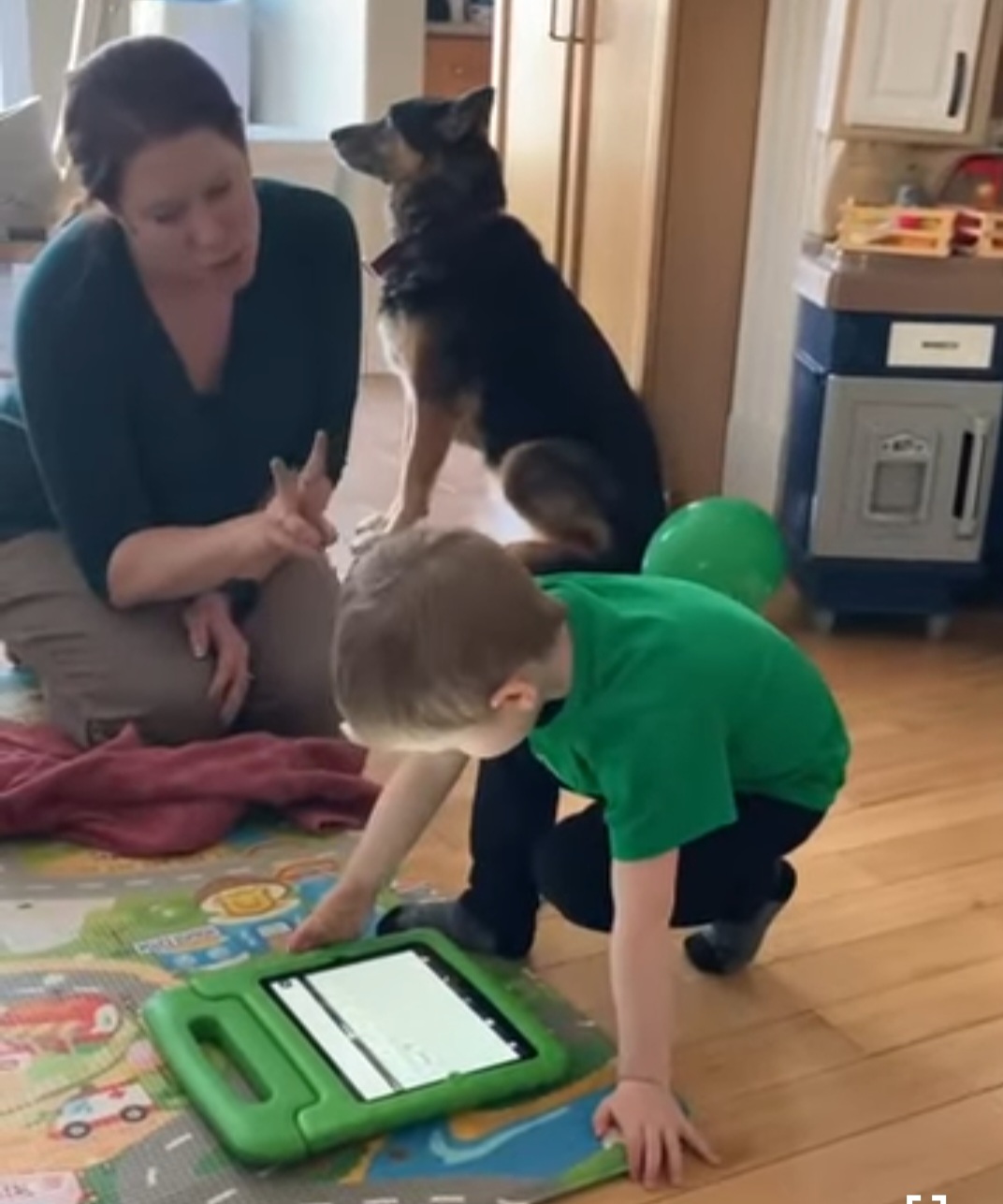 “Dad”, but they both have also been diagnosed with childhood apraxia of speech, which makes the muscle movements needed to speak quite difficult. “Dad”, but they both have also been diagnosed with childhood apraxia of speech, which makes the muscle movements needed to speak quite difficult.
When Paddy was younger, I used to keep a word log to keep track of how many words he could say. The problem was, you might hear a word and then never hear it again, or hear it a year later. He wasn’t using words consistently, and certainly not to communicate. Sometime around his 4th birthday, I stopped writing words down, because weeks turned into months, and months turned into a year without any new words.
With Kelton, I never really kept track of the words he could say, but I definitely noticed when they weren’t coming by the time he was 18 months. I referred him myself to a speech pathologist, and it was the best thing I could have done. Shortly after he started seeing the speech pathologist, he got a diagnosis of ASD, followed by an Apraxia diagnosis this year.
Both of the boys still receive speech therapy at school and privately, but our focus has become more on communication than speaking. Do I wish 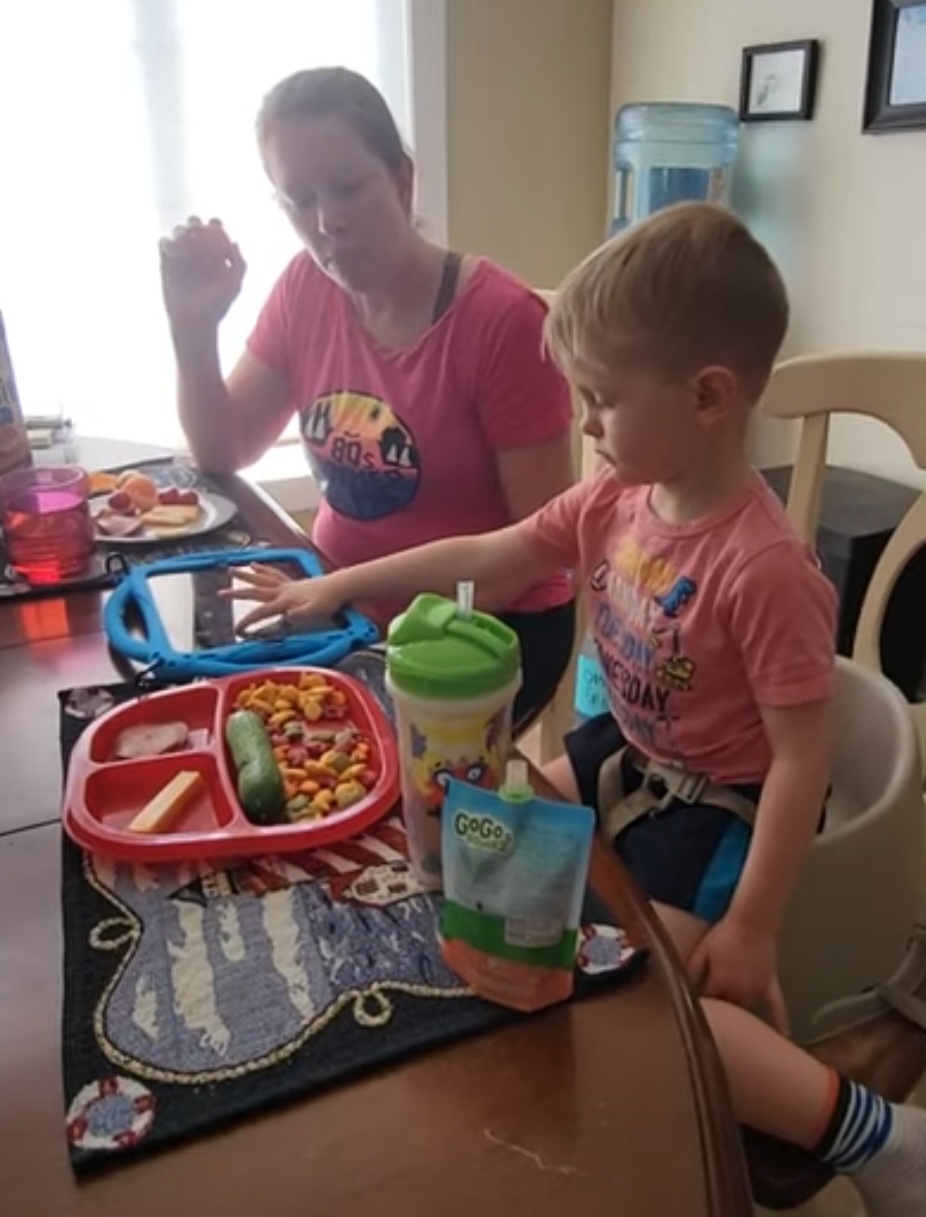 my boys would open their mouths and start speaking someday? Of course I do! I sometimes dream about what their voices would sound like and what topics we would discuss. I also want them to have the fullest life possible, and it’s hard to watch them struggle. my boys would open their mouths and start speaking someday? Of course I do! I sometimes dream about what their voices would sound like and what topics we would discuss. I also want them to have the fullest life possible, and it’s hard to watch them struggle.
Sometime this year, I really started to delve into learning more about my sons’ communication devices, as it occurred to me that the boys were nearing 7 and 4 and were still considered non-verbal. Realizing that my kids may never speak was both heart-wrenching and the motivation I needed to learn how to be a better communicator with them. Even though they cannot speak, I know they have lots to say!
On paper, the boys have the same two diagnoses, but in reality, they are so different! Kelton has really taken to his device, and can ask for things using full sentences, whereas Paddy is having a difficult time navigating the buttons. Kelton is also more social, so he is more motivated to use his device to communicate with us and others. Through our private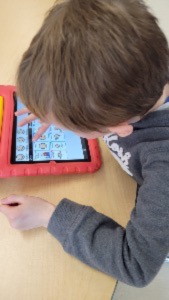 speech pathologist, they have been referred to the I CAN Centre, a place that will determine the best communication device for each boy. speech pathologist, they have been referred to the I CAN Centre, a place that will determine the best communication device for each boy.
We are even attending an AAC (Augmentative and Alternative Communication) camp at the end of August, where all the campers will communicate using their devices, and families will have the opportunity to learn more about the devices while interacting with their children. In the meantime, we will continue to learn signs, provide opportunities to communicate, work with them at their level, and expose them to as much language as possible. Because even though they may not speak, they definitely have lots to say!
|
|
|
Autism Society RMWB

Happy Summer from the Autism Society of the RMWB!
We have officially started our summer camp, Camp Kids First, and children aged 4-5 years old have been having so much fun. From boat rides, to spray parks, to the beach, the children have experienced many activities. For most, this week is their very first summer camp experience, and they have been having a blast!
Our staff members have been amazing with the children, supporting them one-to-one and ensuring they get to experience things they may not be able to otherwise. We have 5 more weeks of fun planned for children ages 6-16, and we cannot wait!
Our admin side of the team is also expanding, and we are SO excited! Stay tuned for updates.
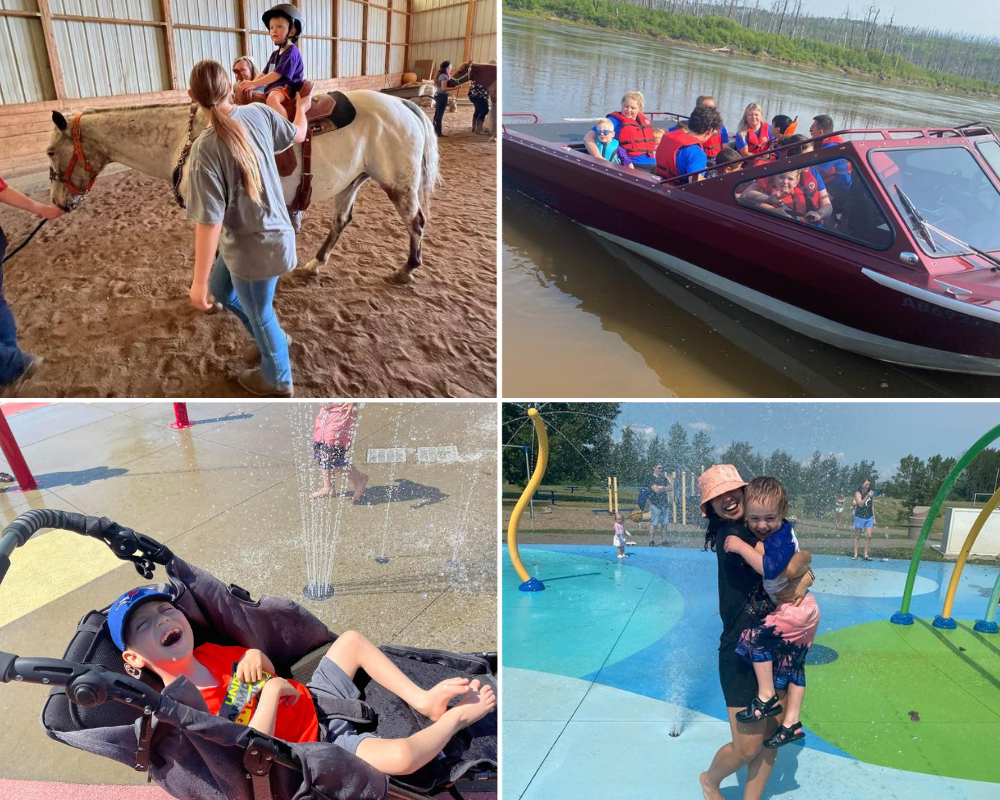
|
|
|
How Do Autistic Girls Present
Differently Than Boys?
Maureen Bennie

From the Autism Awareness Centre Inc. Blog
It is becoming more acknowledged and recognized that girls on the autism spectrum present differently than boys do. The diagnostic ratio has been 3 boys to every 1 girl diagnosed, but is this a true representation of the female population? Autistic females are not being diagnosed, due to their differences in presentation, and on average are diagnosed 2 – 3 years later than boys are. Girls are often missed for a number of complex reasons, but two of the main ones are masking and presenting internally.
Autistic masking, camouflaging, or compensating is a conscious or unconscious suppression of natural autistic responses. It is hiding or controlling behaviors associated with autism spectrum disorder (ASD) that may be viewed as inappropriate in situations. Autistic people may feel the need to present or perform social behaviors that are considered neurotypical, or may hide neurodiverse behaviors in order to be accepted and fit in. associated with autism spectrum disorder (ASD) that may be viewed as inappropriate in situations. Autistic people may feel the need to present or perform social behaviors that are considered neurotypical, or may hide neurodiverse behaviors in order to be accepted and fit in.
Regular masking can have a profound impact on a person’s well-being. Some of the negative effects of masking are:
- exhaustion and fatigue – masking takes a lot of effort
- change in self-perception or self-identity (not feeling like one’s true self, feeling like a “fake”)
- increased stress and anxiety
- depression
- autistic burnout
- a delayed autism diagnosis
- increased risk of experiencing thwarted belongingness and lifetime suicidality
Why are autistic traits in girls missed, dismissed, or overlooked?
Autism is diagnosed by observing behaviors. If those behaviors are shown in an external way, a referral will be made. If behaviors are internalized, like in the case of masking/camouflaging, and the person doesn’t cause any disruptions or problems, they may be overlooked. It is not until the point that mental health has deteriorated to the stage where behaviors have become more visible that help is sought.
Female behaviors are often stereotyped. Society accepts certain behaviors as being typically female such as being shy, quiet, or withdrawn. For example, if an autistic girl doesn’t want to get her hands messy, that is acceptable because girls are neat and tidy and boys aren’t. If she is quiet in the classroom and not causing any disruptions, she is not singled out for concern.
Interests of autistic girls may be deemed more typical and socially acceptable than males’ interests are. Interests such as drawing, reading, animals, and figurines are common among girls. No one sounds the alarm when a girl is engaged in these pursuits for long periods of time. Trying to fit in with non-autistic friends, studying how to behave and what to say in order to fit in (think of masking), can become an interest on its own.
Repetitive and restrictive behaviors may not be the ones typically thought of, such as lining up objects or using echolalia. Girls may like re-reading the same book, watching the same program over and over, and writing about the same thing because it satisfies the need for predictability. My daughter engages in all of these repetitive behaviors.

In the publication Autism, Girls, and Keeping It All Inside from the Autistic Girls Network, the authors stated:
Autistic girls and boys or non-binary young people, who present in an internal way may tend to internalize problems too, and this can cause damage to their mental health which is already in peril from camouflaging their autism. It can lead to increased anxiety and situational mutism (being unable to speak in situations which cause high anxiety or feel unsafe). Because this is an internal behavior and is not a core feature of the diagnostic criteria of autism, despite being common in the cohort we’re looking at, it can also cause these young people to be misdiagnosed if the assessor doesn’t understand internal presentations (Hull, Petrides, and Mandy, 2020).
What does an internal presentation of autism look like?
The following lists are highlights from the Autism, Girls, and Keeping It All Inside publication. This is not the entire list, so I would encourage readers to investigate further by reading this excellent publication.
Friendships
- May be on the edge of friendship groups or have intense friendships vulnerable to falling out.
- May be very uncomfortable with conflict.
- May prefer to play in their own way.
School
- May not raise a hand in class or be reluctant to speak when called on.
- May be unable to use strategies like Time Out cards because of situational mutism.
- May misunderstand pop culture or trends.
- May experience less difficulty and anxiety if seated with a friend, and if the seating doesn’t change.
- May also vastly prefer pair or group work with a friend – it’s difficult and anxiety-inducing to speak to someone they don’t know well.
- May mask at school, explode at home.
- May be disinterested in sport.
- May use compensation techniques to disguise difficulties from teachers.
- May get by in primary school, but the transition to secondary is an explosion in sensory and cognitive input – a step too far.
- May have an ability to spot patterns and/or consider a subject without bias (if you can get them talking in the first place).
- May avoid or be uncomfortable with unstructured time at school and need support for these times more than lessons.
- May find aspects of a school uniform (or other clothes) difficult or impossible – reasonable adjustment needed.
- May find transitions between classrooms very difficult.
- May be unable to eat in the cafeteria due to the sensory aspect of smell and so many people.
- May find assemblies difficult due to the proximity of so many people.
- Will be startled and scared by teachers shouting at them or the class.
- May find lessons like PE (or perhaps Food Tech and Design and Technology) difficult due to lack of structure or predictability and sensory reasons.
- Will need specific and adapted sex education.
Anxiety
- May have situational mutism.

- May be prone to extended absence from school.
- May have an eating disorder.
- May self-harm.
- May have anxiety manifesting in physical symptoms e.g. stomach ache.
- May be more likely than peers to have mental health issues.
Autistic Inertia (difficulty stopping and starting activities)
Autistic inertia makes transitions difficult, and also accounts for processing delays, because when the brain is devoting its processing energy to an interest of choice, there’s not much left over to deal with interruptions.
- May have difficulty with organization.
- May find it difficult to get started on a project or assignment.
- May find it difficult to build a plan without breaking it down into smaller segments.
- Likely to have an intense focus on what is of interest.
- May find it difficult to be interrupted when ‘in flow’.
- Likely to find transitions of all kinds difficult.
Other Considerations
- May have a vivid imagination.
- May enjoy collections – collecting IS the play, rather than doing something with the items collected. (My daughter’s passion is Sonic plushies and Playmobil)
- Can be perfectionists.
- Stimming (repetitive behaviors) less likely to be noticeable – small movements or internalized.
- Likely to have strong opinions when not masking in a safe space, and difficult to convince they are wrong.
- May have trouble with directions.
- May have a large or advanced vocabulary.
- May make strong use of routine or ritual.
- May have poor posture.
- May have restricted eating choices.
- As likely to be creative as into STEM.
Why do girls need a diagnosis?
When girls do not receive a diagnosis, and the supports that they need for their well-being, they often end up with mental health issues such as anxiety or depression. They are at a higher risk for suicide. They are more prone to eating disorders such as Avoidant and Restrictive Food Intake Disorder (ARFID). Feeling like you are struggling without a diagnosis can also lead to poor self-esteem. An autistic person has the right to know they are autistic and a chance to learn more about themselves and develop their identity. Girls have needs that are unique to them and deserve to be recognized and supported in a way that helps them to thrive.

I have an autistic son and daughter, and I see how autism manifests itself differently in each of them every day. My daughter fits much of the internalized presentation profile and has many of the autistic female traits. Had she not had a profound language delay, she may have flown under the diagnostic radar for much longer than she did. Early diagnosis and supports starting at the age of 23 months have had a positive impact on her development.
References
Autistic Girls Network (2022) Autism, Girls and Keeping It All Inside. Autistic Girls Network
https://autisticgirlsnetwork.org/wp-content/uploads/2022/03/Keeping-it-all-inside.pdf
Resources for Girls
Scottish Autism Online Support Programme for Autistic Women and Girls
Autistic Girls Network
Autism in Girls (2015 Lecture by Tony Attwood)
Symptoms of Autism in Girls
Behind the Mask: Autism for Women and Girls
Spotlight on Girls with Autism Booklet
Supporting Autistic Girls at School
What Every Autistic Girl Wishes Her Parents Knew
Autistic Female Voices and Perspectives
Authentically Emily
Autistic Hoya
Everyday Autistic
Judy Endow – Aspects of Autism Translated
Musings of an Aspie
|
|
|
Sinneave Family Foundation
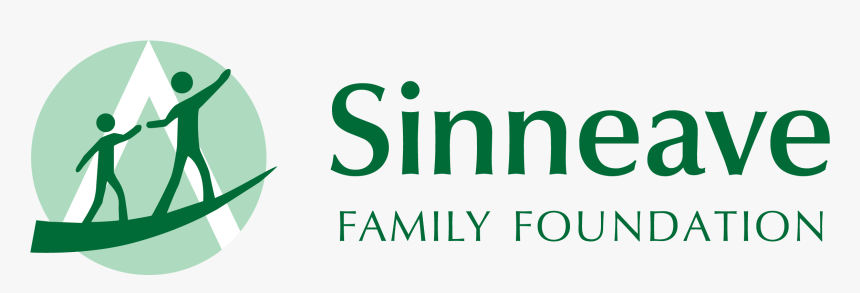
It’s summer at Sinneave, and we sure wish you were here!
This is your official invitation to spend some time with us this summer, starting with our Summer Workshop Series. We are offering free, drop-in workshops focusing on different aspects of communication, executive functioning, and acceptance and commitment training. Each 90-minute workshop covers a different topic, providing practical tips and strategies to help improve your ability to connect and thrive in social situations. Check the events page on our website for all the dates, times, and topics – from now through August 25th. See what’s coming up by clicking here.
We’re also offering a free, virtual workshop all about moving. If independent living is a goal of yours, or if you are a parent, caregiver, or professional who supports an adult on the spectrum who is thinking about moving, Sinneave’s housing specialists will be sharing their learnings along with practical tips, checklists, and things to think about before you move. Join us online, on August 9 from 6:30 – 8:30 p.m. Register on our website by clicking here.
We can’t wait to see you!

|
|
|
Task Analysis Part 3
Carmen Moore
Task analysis is the work of breaking down complex skills into smaller, more manageable steps. This article will give some ‘real-life’ applications that I have used or plan to use, using task analysis in my life as a teacher/parent.
Before I delve into these, I want to make an important point. Task analysis can be used alone, but, like many research-based strategies, it is more effective when used alongside other strategies. For example, when using task analysis to teach a new skill, you may want to also use some prompting along the way, to encourage the learner to keep going with each step. You may also want to create a related visual of each step as a reminder for the learner, to which they can refer to help make the process errorless. You may want to model every step of the task before they attempt to do it, or model each step along the way for the learner to be successful. You may want to create a video model for the learner to reference, as a primer to be watched before attempting the task or each step of the task. This can be very helpful, as the learner can watch it as many times as needed, or pause along the way to match where they are in the process. (I have certainly done this myself when I use a how-to video on home improvement.) Lastly, if needed, provide a reinforcer when the entire task is completed (or even for each step of the task if needed to begin). This is often overlooked, so I like to highlight that piece. We need to have more celebrations! want to create a video model for the learner to reference, as a primer to be watched before attempting the task or each step of the task. This can be very helpful, as the learner can watch it as many times as needed, or pause along the way to match where they are in the process. (I have certainly done this myself when I use a how-to video on home improvement.) Lastly, if needed, provide a reinforcer when the entire task is completed (or even for each step of the task if needed to begin). This is often overlooked, so I like to highlight that piece. We need to have more celebrations!
I will give some examples of two of the three methods for using task analysis.
Forward Chaining:
One great example from my own life is ordering a meal service called Hello Fresh occasionally (I am not a paid endorser – just a fan of their effective use of task analysis). At first, I was ordering it as a great way to help with the daily decision of  ‘what are we having for supper?’, as well as helping me to learn to cook. I then realized their accompanying visual page had each step broken down, with a visual and small explanation of each step of the process to cook this meal, which was the key to my success. Once I got confident, I started using the visual, the write-up, and the supplied ingredients to begin to teach my son to cook. At first, I was asking him to do each step with me to learn, but he kept refusing completely. Once I thought of using task analysis/forward chaining, I told him that I just expected him to help with the very first step of the recipe instead of the whole thing, and that was the winning idea! Once he got used to that, we moved to the first two steps, then the first three, etc., until he was able to move through the recipe. This entire process takes quite a while, and will depend on the interest and ability of the learner. This exemplifies the motto of ‘good for all, critical for some’. ‘what are we having for supper?’, as well as helping me to learn to cook. I then realized their accompanying visual page had each step broken down, with a visual and small explanation of each step of the process to cook this meal, which was the key to my success. Once I got confident, I started using the visual, the write-up, and the supplied ingredients to begin to teach my son to cook. At first, I was asking him to do each step with me to learn, but he kept refusing completely. Once I thought of using task analysis/forward chaining, I told him that I just expected him to help with the very first step of the recipe instead of the whole thing, and that was the winning idea! Once he got used to that, we moved to the first two steps, then the first three, etc., until he was able to move through the recipe. This entire process takes quite a while, and will depend on the interest and ability of the learner. This exemplifies the motto of ‘good for all, critical for some’.
Another example is when I was teaching my son to multiply two-digit numbers by two-digit numbers. I told him that there were many steps to doing this, but I only needed him to do the first step, and I would complete (model) the rest of the steps. He liked the idea of me doing most of the work. I explained the first step of which digit to multiply, and where to write the first number, and then had him simply watch me finish it out for him. He loved that ‘I was doing all the work’, but it was an excellent way to have him watch my modeling and participate in a way that kept his anxiety down. Next, I had him complete the first two steps of the math problem and watch me finish the rest. Then the third, then fourth, etc. until he was doing it all himself. This was an excellent way to help overcome his math anxiety surrounding a multiple-step equation.
Backward Chaining
This process was perfect for teaching my son to load the dishwasher the way that I like it done. Admit it – there is a way. I knew that beginning with all the dishes at once would be off-putting for him, so, to keep it errorless, I decided to use backward chaining. I started by explaining that all he had to do was to watch me load the dishwasher, and then asked him to set the very last plate in the last spot available. I gave him a high five and off he went! The next time, I had him put in the last three plates, high five, and off he went again. The third time, I had him do all the plates and two pieces of silverware. We progressed eventually to him loading all the silverware and plates, with me doing the top rack of glasses. Lastly, I had him load the plates, silverware, a few glasses, and then all of it. We had small reinforcers along the way to keep him motivated, but in the end he was just proud he had acquired another new skill.
In his writing, we also used backward chaining to learn to write a good paragraph. It was too much to get him to write it all at once, so I wrote the introductory sentence and the three details, and had him simply come up with a good concluding sentence that I wrote. The next week we repeated the process, but he thought of the last sentence as well as writing it. After that, I wrote the first three, and he thought of and wrote the last two. Eventually, he was writing the last three, then four, then all five! It was a longer process than I would have usually done, but I know that writing is more difficult, so task analysis/backward chaining was sure to help the process. and the three details, and had him simply come up with a good concluding sentence that I wrote. The next week we repeated the process, but he thought of the last sentence as well as writing it. After that, I wrote the first three, and he thought of and wrote the last two. Eventually, he was writing the last three, then four, then all five! It was a longer process than I would have usually done, but I know that writing is more difficult, so task analysis/backward chaining was sure to help the process.
This has been an excellent strategy for learning new skills, especially those involving multiple steps. I hope you find it useful when helping to support a learner with any new multi-step direction or process. It has applications in most realms of life, I have found.
|
|
|
Society for Treatment of Autism

Mental Health Across the Autism Spectrum Counselling Service
Our specialized service is provided by clinicians (psychologists, occupational therapists, and speech-language pathologists) with expertise in autism spectrum disorder (ASD) and mental health. We use evidence-based therapies such as cognitive behavioural therapy, solution-focused therapy, motivational interviewing, and behaviour modification. Therapeutic activities are modified to account for the unique learning differences that people with ASD tend to experience.
Who is it for?
Individuals age 10+ with ASD or those who identify as having autism and their family members. To benefit from counselling, individuals must have the ability to talk with a counsellor about their thoughts, feelings, and experiences.
Services Offered
We offer individual, family, and group counselling sessions. For more detailed information go to our webpage here. We accept FSCD funding and private insurance, as well as have a limited sliding scale according to your household income to help ensure that services are accessible. Call or email us to inquire about counseling services. Phone 403-253-2291 or email counselling@sta-ab.com.
Help Spread the word about Ready, Willing and Able at STA
Helping Youth and Adults with Autism Find Work and Fulfillment
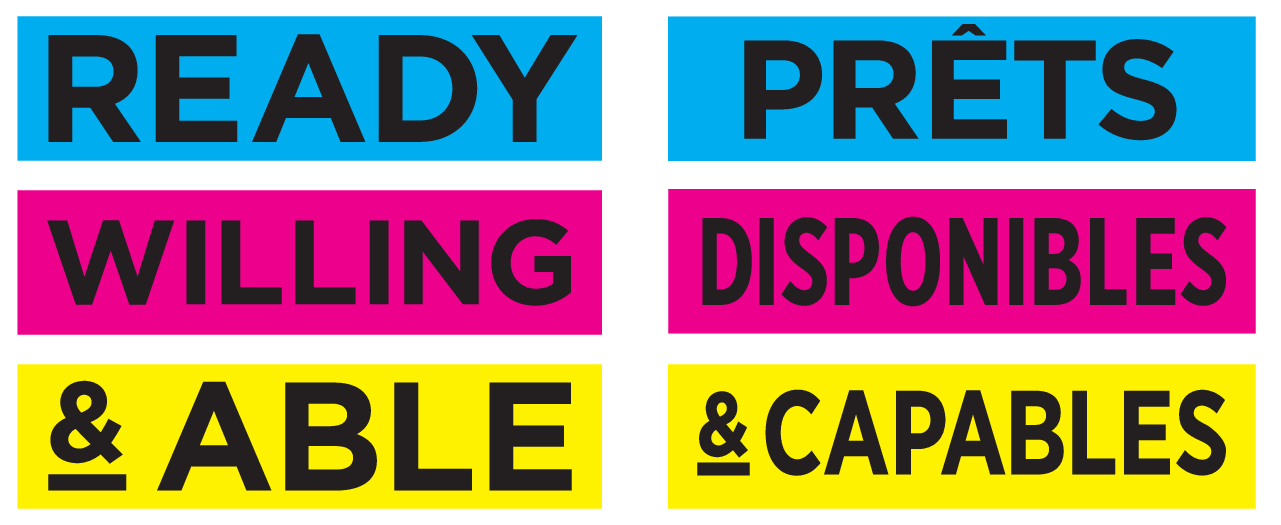
We are so pleased to announce the ongoing success of our partnership with Ready, Willing, and Able (RWA). Funded by the Government of Canada and active in 30 communities across the country, RWA is designed to increase the labour force participation of people on the autism spectrum and/or with an intellectual disability. STA is focused on supporting autistic job seekers within Calgary and surrounding areas.
Through STA’s Pre-Employment Program, job coaches support autistic job seekers to improve interview skills, build resumes, and help with job searching. Once hired, RWA provides funding to STA’s successful Employment Program to support autistic employees as well as their employers.
We are proud to tell that story in new videos that chronicle the program and feature some of our clients and their employers. We’re proud of the work we’ve done. But there are so many more people for whom this program could provide transformative benefits. That’s why we hope you’ll share these videos, in the hopes that more individuals and families with autism will learn about the program, and more employers will want to hire inclusively.
Adolescent and Adult Services Program - STA Video
Ready Willing and Able / STA Video
|
|
|
The Bond with Horses
Frank Power
Over the past week, both of our boys got to experience the connection that an animal like a horse can have with a child with autism. As we all know, every child with ASD is different, and may not react similarly to a situation. Our boys are currently 7 and 4 years of age, and Paddy has been exposed to horses since he was around 3 years old. Kelton, being much younger, has been introduced to horses, but has been more timid than his brother when it comes to connecting.
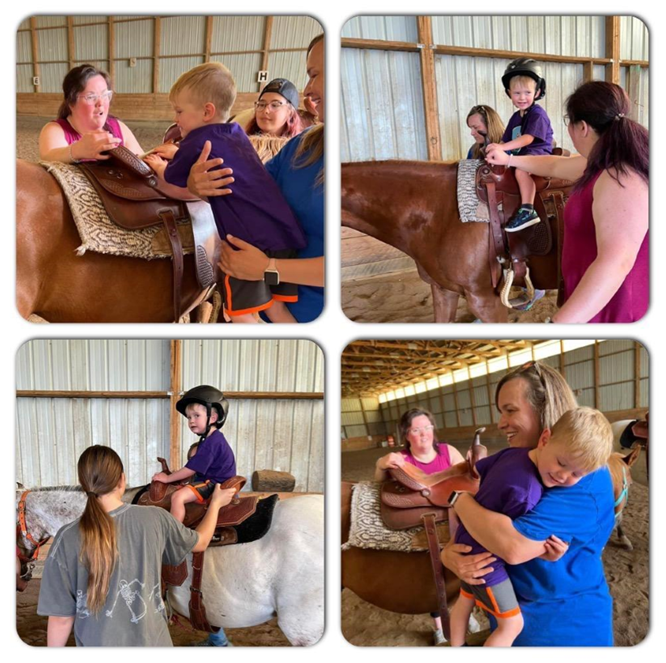
Up until December last year, Paddy's respite worker Nicole and her family had 3 horses, and Paddy had many opportunities to socialize. On outings, Paddy would walk around the stable, explore the little barn, or even get pulled around in a sled or wagon. The Rankin family always welcomed our boys, whether it was for respite or just a drive out to visit. We even had a special cover made for Paddy’s helmet for the times we went for a ride.
For Paddy, the love and connection were instantaneous. The animals were so large in stature, but were always gentle and aware of him around them. They were never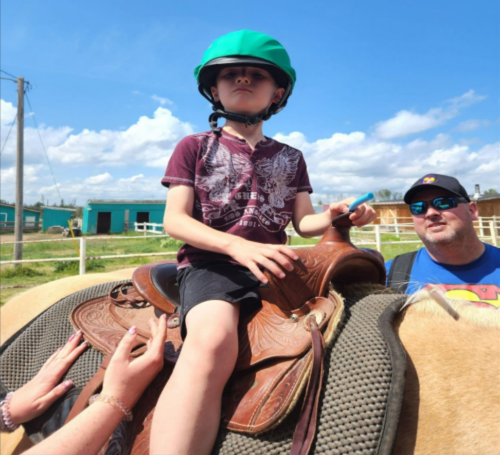 scared of Paddy, regardless of the high-pitched noises, arm-flapping, the contact, or when he rubbed up on their face. When Paddy was around, he was considered one of the crew. When I first learned of his diagnosis, all that went through my head was the things that Paddy might not be able to do. That day, we saw him jump up, sit down on the back of this large animal, and go for a ride – so calm and happy. It changed everything for me. scared of Paddy, regardless of the high-pitched noises, arm-flapping, the contact, or when he rubbed up on their face. When Paddy was around, he was considered one of the crew. When I first learned of his diagnosis, all that went through my head was the things that Paddy might not be able to do. That day, we saw him jump up, sit down on the back of this large animal, and go for a ride – so calm and happy. It changed everything for me.
Kelton was not as open, and had some fear when it came to the large animals. Anytime we tried to approach a horse, he wanted nothing to do with it, and got upset. Up until the past weekend (when we did another drive-through and stopped to visit our friends), he didn't want to be around them. Things had changed during the week, as he was taken to the stables with his summer camp. We weren't there, but many people knew who Kelton was, even those at the ranch. To our surprise, at the end of the day, we were sent pictures of Kelton riding a horse. From what was explained, it was hard to get him started, but once he got up on the saddle he was at ease with the horse. They understood each other.
From the perspective of a father, this was fantastic. We hope this wasn't a one-time opportunity and that he will do it more. The patience of everyone involved with this is 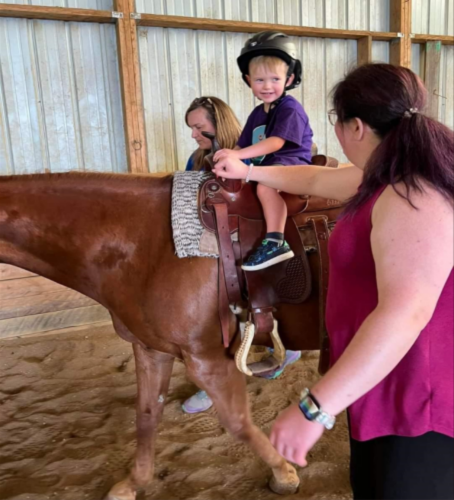 incredible, and it was so nice to see this being offered to my son, and him enjoying it. As parents, it is hard to find activities that our boys would enjoy, especially for both of them. We need more opportunities for kids to participate in these experiences. There may be some places that are not commonly known about. incredible, and it was so nice to see this being offered to my son, and him enjoying it. As parents, it is hard to find activities that our boys would enjoy, especially for both of them. We need more opportunities for kids to participate in these experiences. There may be some places that are not commonly known about.
As a parent and an advocate, I have developed an understanding of what it truly means to have opportunities for all, no matter the ability level. For myself and so many others that live a similar life, this is something that never goes unnoticed. This week we were lucky to have both of my boys experience the calmness and connection that comes with riding a horse. A connection can be difficult to have and maintain, but when it happens it's something that is au-some! Through the opportunity of riding a horse, the boys got to experience that special connection.
|
|
|
Centre for Autism Services Alberta

Happy Summer! The Centre for Autism Services Alberta has some great summer programs in store!
We’ve got summer camps for children and teens with ASD, ages 3-17 years old! Learning new skills, having fun, making friends, and creating summertime memories in a safe, supportive environment – that’s what our summer camps are all about. Centre summer camps are designed for all kids with autism, regardless of the impact of their diagnosis. All camps are supervised by centre-trained aides and employ a high staff-to-camper ratio. Each week of camp for all age groups has a different, super-fun theme to choose from!
It’s not too late to register for camp weeks in August!
Thinking about getting a job? EmploymentWorks offers employment readiness training, job sampling, and work experience opportunities for individuals with a disability, including but not limited to autism!
To inquire and to register, send us an email at Employment Works. Start your job search today!
We are accepting applications for Facing Your Fears for September 2022. This program is for ages 8-14 and is designed for children on the autism spectrum who are having difficulties managing their anxiety. A well-developed caregiver education component is part of the program, allowing strategies learned in groups to be implemented at home.
- This 13-week program consists of 90-minute sessions, once per week
- Focuses on helping children and their caregivers identify worries, develop coping strategies, and practice managing anxiety with guidance from program facilitators
- Caregiver participation is required
- Delivered by a registered psychologist and occupational therapist
- Funding may be provided by FSCD
For more information and to apply, please contact Anne Beattie at 780-488-6600 ext. 314, or email abeattie@centreforautismab.ca
Looking for awesome summer fun? Check out our Accessible Summer Fun Guide 2022 on our website! We list tons of great parks, splash parks, facilities, and unique activities in and around the city that are sensory friendly, such as NEW Sensory Nights at the Alberta Aviation Museum!
|
|
|
Meet ASA's Family Resource Coordinators
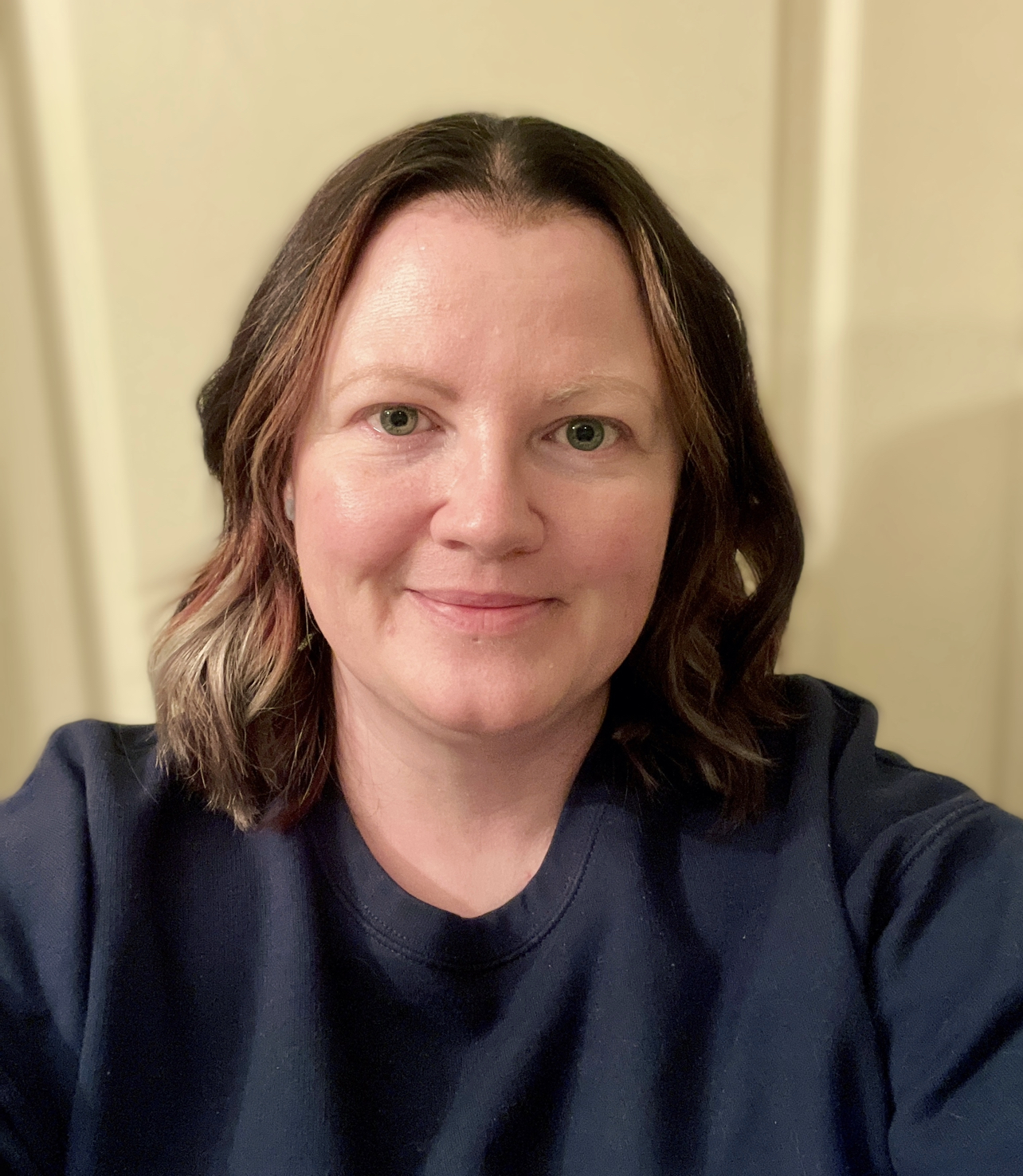
Hello! My name is Stephanie Williams, and I’m privileged to be the Family Resource Coordinator (FRC) for Medicine Hat and surrounding areas. I have two amazing children. Tye is 12, and a trampoline superstar! He is also autistic and has ADHD. Ravyn is 19 and currently attending the Medicine Hat College in the education program. Rounding out our family is my partner in crime, Ross. I have previously worked as an Early Childhood Educator and as an Educational Assistant. Along with my best friend, I am also a founder and admin of the Autism & Friends Medicine Hat Facebook group. Working with individuals and families is a passion of mine, so when I’m not busy being an FRC, I’m also a developmental aide for families in our community. I love being a part of the Medicine Hat community! I also love to help those who reach out to the FRC, letting them know all that Medicine Hat has to offer.
Stephanie can be reached at FRCmedicinehat@autismalberta.ca or you can follow the Medicine Hat FRC on Facebook here.
|
|
|
|
|